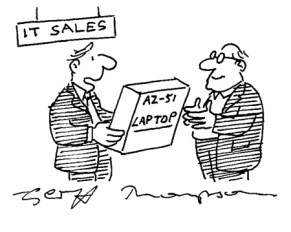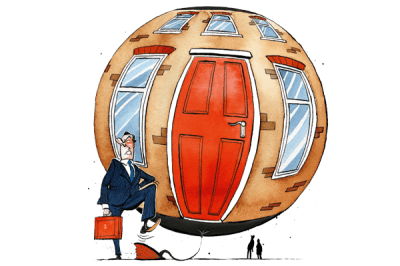Ten years ago next week, the tech-heavy Nasdaq stock exchange hit its lowest point ever, as the dotcom crash shuddered to an excruciating conclusion. With Facebook shares now approaching half their May offer price and debate raging over the role of banks in society, this is a good time to ask what we learnt from that enigmatic earlier shock — the answer being not enough.
Even by the standard of bubble-induced collapses, the dotcom crash was thorough. The Nasdaq Composite index, which had peaked in March 2000 at over 5,000 points and halved by that year’s end, hit a low of 1,114 in October 2002. By then, almost nothing was left of this pioneering sector, save a trail of eery ‘ghost sites’ on the Web — whose first version, 1.0, was essentially demolished. The Wall Street Journal likened the $3.3 -trillion losses sustained by tech investors to ‘one third of the houses in America sliding into the ocean’.
But how had the crash happened? A post-mortem narrative emerged (and is still pretty much accepted) in which twenty-something CEOs had drunk their own bathwater and begun to feel invincible. Tales of basketball courts and DJ decks in offices; of Willy Wonka-themed parties and drugs-fuelled junkets to Vegas; of company-wide first-class travel and $2,000 Aeron chairs for all did nothing to discourage such a view.
And of course there was industrial-scale hubris. In New York, Josh Harris, CEO of the wild ‘webcasting’ giant Pseudo.com, spent millions on social experiments designed to illustrate his darkening view of the net. Michael Saylor of the ‘data mining’ firm Microstrategy hired the Washington Redskins’ stadium for Super Bowl parties and spoke of running for president: he also bought a plot of land upon which — without even a hint of irony — he intended to build an exact replica of the house in the film version of The Great Gatsby. Fingers in need of pointing were not short of targets that year.

Yet the official story always looked incomplete to me. Could an entire industry be laid waste by overspending on office furniture? And if the kids didn’t know how to run businesses, why did Wall Street and investors back them so enthusiastically?
The background to this boom and crash is worth recalling. Kids with no business experience had run dotcoms because almost no one over 30 understood the internet. Hard though it is to believe at this remove, the net began as a utopian subculture and those who were online tended to treat the experience as something akin to divine. Before the mid-1990s there was no commerce or control, and knowing how to set up a modem qualified you as a cybersage of the highest order.
Then came the August 1995 Wall Street flotation of Netscape, makers of the first commercial web browser. By this time, word that the internet might be important had begun to spread, but it wasn’t until Netscape shares rose from $14 to $75 within hours of hitting the market that this interest became a mania. Marc Andreesen, one of two 23-year-old computer students who had designed Netscape’s precursor with no notion of making money, ended the day worth $58 million and would be featuring in a Miller Lite ad by the end of the decade. The net was nobody’s secret any more.
‘We were like gods that year,’ one ex-financier told me. ‘We were basically handing out money’
What happened next is mind-boggling. The first wave of dotcoms in San Francisco’s Silicon Valley and New York’s ‘Silicon Alley’ tended to look like businesses and were often well-run. But as the decade progressed, the time lapse from a company’s formation to flotation collapsed. In the past, three years of accounts and several quarters of profit were demanded by investment bank underwriters as a condition of going public, but by the IPO frenzy of 1999, all such standards had fallen away.
Some of what followed was comic. One company, AllAdvantage.com, paid users 53 cents an hour to surf the Web, plus another ten for every friend they referred, with the aim of collecting valuable intelligence on consumer habits. Unfortunately, having accounted for 30,000 members in their first quarter, they drew two million (people wanted free money? Who knew?) and with each customer earning an average of $20, the bill came to $40 million… meaning that the more successful AllAdvantage became, the more wildly, prodigiously unsuccessful they became. Fortune dubbed them ‘the dumbest dotcom in the world’, but their story is suspiciously typical of the later dotcoms, many of which were rushed to market after only 18 months in business and with no clear path to profit.
By 1999 and into early 2000, as the Nasdaq tech index reached a dizzy peak, dotcom IPOs had developed a pattern. Typically, a stock would be offered to market at between $9 and $18 per share. Public hunger for these much-hyped shares was high, so the opening would be delayed — sometimes by hours — while demand built. Upon release, the stock would fly from the traps like a greyhound, reaching up to five times its offer price, before falling back from mid-afternoon as a starved public finally made it through the door.
This was good news for insiders who had bought shares at the offer price, but as most of the dotcom kids only realised afterwards, it was bad news for them. Typically, their businesses would be left with absurdly high valuations, which took energy to defend and made raising fresh capital difficult. More importantly, the dotcom only received money for shares sold at the offer price: subsequent inflation generated no extra capital for them. In other words, the dotcoms were being systematically underpriced at IPO. But why?
Only towards the end of research for my book Totally Wired did a clear explanation start to emerge, when an interviewee pointed me in the direction of a little-publicised $12.5 billion class action lawsuit against 55 Wall Street underwriters, most of them investment banks. The suit described a practice called ‘spinning’, in which underwriters allocated tranches of shares at offer price to favoured or potential clients, who could then ‘flip’ them into the opening frenzy for an instant profit.
More incendiary by far, however, was the class action’s description of a device called ‘laddering’, by which clients received share allocations on condition that they agreed to buy more post-opening, at predetermined higher prices which could be staggered through the day, so deliberately escalating the price. The lucky clients would then be free to sell all of their shares to ‘retail’ investors — members of the public — at the mid-afternoon top of the market, sometimes ‘shorting’ them on the way down for good measure. ‘We were like gods that year,’ one ex-Goldman staffer told me, referring to 1999. ‘We were basically handing out money.’
The class action ran from 2001 and was settled for a paltry $586 million in 2009, as plaintiffs feared a large-scale banking collapse and no recompense at all. Throughout, the defence case rested not on a denial that ‘spinning’ and ‘laddering’ had taken place — but on an insistence that these practices were not illegal. A view I found shared by Professor Joseph Grundfest of the Stanford Law School, a former commissioner at the Securities and Exchange Commission. No wonder a member of J.P. Morgan’s legal team purred, ‘Our client is pleased with the outcome.’
So the dotcom ‘bubble’ was exuberant, but not irrational. In effect, it was a heist. Investment banks had used the young businesses as financial vehicles, conveying them to market regardless of virtue, much as they would sub-prime mortgages. Indeed, given that much of the money withdrawn from technology went into real estate, it is possible to view the two crises as one.
A bitter truth: by dragging the case out for eight years, delaying its acceptance as a class action until 2004 and then forcing a settlement with no admission of guilt, banks stifled information which might have helped prevent the financial crisis from which we’re still reeling.






Comments